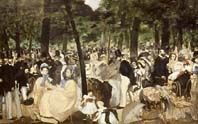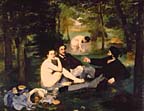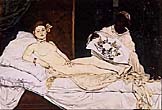Edouard Manet
{mah-nay', ay-dwahr'}, b. Paris, Jan. 23, 1832, d. Apr. 30, 1883, has
often been called the first modern artist to conceive of a painting
as a flat surface covered with pigment, and purposely to draw
attention to the process of painting.  Although he was not completely unconcerned with
subject matter, Manet used the traditional concept of content only as
a point of departure -- one that led him in many different
directions.
Although he was not completely unconcerned with
subject matter, Manet used the traditional concept of content only as
a point of departure -- one that led him in many different
directions.
Manet was a member
of an aristocratic family, and his father, a government official,
only reluctantly countenanced his son's avowed intention of becoming
a painter. After completing his academic studies and failing in a
half-hearted attempt to win a commission as a naval officer, Manet
studied painting under Thomas Couture and later traveled (1856) to
Holland, Germany, Austria, and Italy to visit art collections. His
early works, such as The Spanish Guitarist (1860; Metropolitan Museum
of Art, New York City), reveal a debt to Diego Velazquez and
Francisco de Goya, but they also display the two-dimensional
directness that would mark Manet's more controversial paintings.
Once he moved away
from Spanish subjects and the general influence of baroque art to
explore themes that gave a quick and vivid sense of the passing
social scene -- a street singer coming out of a cafe, gatherings of
people in the Tuileries gardens -- he embarked on a series of
provocative challenges to the official Salon art of the day.  The
first of these unconventional works was the Dejeuner sur l'Herbe
(1862; Musee d' Orsay, Paris), refused by the Salon of 1863 but given
a showing that year when the outcry about the rejection of
experimentalist works led to a special exhibition to accommodate
them, the famous Salon des Refuses. Although Manet manifested his
admiration for past art by basing the Dejeuner poses on Marcantonio
Raimondi's print (c.1525-30) after Raphael's lost cartoon for the
Judgment of Paris, the general public was shocked both by the
bohemian candor of the subject matter and by the very summary way in
which the brushwork suggested lighting and textures. The painting
looks unfinished and gives the impression of an informal moment
captured as if by a camera -- features that would serve as a stimulus
to the younger impressionists.
The
first of these unconventional works was the Dejeuner sur l'Herbe
(1862; Musee d' Orsay, Paris), refused by the Salon of 1863 but given
a showing that year when the outcry about the rejection of
experimentalist works led to a special exhibition to accommodate
them, the famous Salon des Refuses. Although Manet manifested his
admiration for past art by basing the Dejeuner poses on Marcantonio
Raimondi's print (c.1525-30) after Raphael's lost cartoon for the
Judgment of Paris, the general public was shocked both by the
bohemian candor of the subject matter and by the very summary way in
which the brushwork suggested lighting and textures. The painting
looks unfinished and gives the impression of an informal moment
captured as if by a camera -- features that would serve as a stimulus
to the younger impressionists.
Manet again caused
public scandal with his Olympia (1863; Musee de Orsay) a candid
presentation of a courtesan posing naked on her bed. The homage paid
here to Titian's famous Venus of Urbino (c.1538; Uffizi Gallery,
Florence)  only
aggravated the outcry created by the suggestive props accompanying
the nudity and by the use of bright color-patches that are juxtaposed
without any graded transitions of modeling.
only
aggravated the outcry created by the suggestive props accompanying
the nudity and by the use of bright color-patches that are juxtaposed
without any graded transitions of modeling.
Manet's thoroughly
unconventional treatment of traditional subjects represents a turning
point in modern painting. Even more than the proponents of realism,
led by Gustave Courbet, Manet devalued the importance of what was
painted in favor of stressing the process by which a painting was
created. His later works ranged in subject matter from beach and
outdoor subjects to city scenes, all of which he rendered with
increasingly free brushstrokes and bolder use of color and light.
Although he maintained close contacts with the emerging
impressionists, his predilection for strong black-and-white contrasts
and his feeling for clear outlines kept him outside the mainstream of
impressionism. The crowning masterpiece of his last years, A Bar at
the Folies-Bergere (1881-82; Courtauld Institute Galleries, London),
acknowledges the triumph of impressionism in its use of quick,
vibrant strokes to enhance the fall of light onto textures and
surfaces, but it also testifies to Manet's personal, inventive
brilliance in the way in which different aspects of visual experience
are combined in startling and illogical ways. By the time of his
death, in 1883, Manet had passed from being the abomination and
source of outrage of mid-19th-century French art to being recognized
widely as a pioneer of the modern movement in painting.
Mark Roskill
Source: The Grolier Multimedia Encyclopedia, Release #9.01, ©1997
Bibliography: F. Cachin, Manet (1983); T.A. Gronberg, ed., Manet: A Retrospective (1988);
O. Friedrich, Olympia: Paris in the Age of Manet (1992); George H. Hamilton, Manet and His Critics
(1986); Anne C. Hanson, Manet and the Modern Tradition (1977); Edouard Manet, Manet, ed. by Pierre
Courthion (1963); Sandra Orienti, The Complete Paintings of Manet (1970); V. Perutz, Manet (1991);
Theodore Reff, Manet and Modern Paris (1982); John Richardson, Manet, 3d ed. (1976; repr. 1989);
Pierre Schneider, The World of Manet (1968).
Images: "Concert at the Tuileries", "Dejeuner sur l'herbe", "Olympia"
Copyrights Notice and Disclaimer: Images of artists' works displayed throughout this site have
been obtained from numerous sources, including digital libraries at educational institutions,
educational software, and Mark Harden's Artchive.
Credit is attributed when known. Some works are considered to be in the public domain, based on current
U.S. and international copyright acts. For more information on copyright laws, please refer to the
Artists Rights Society and Benedict O'Mahoney's
The Copyright Web Site. [See also:
DiscoverFrance.net Copyrights.]
